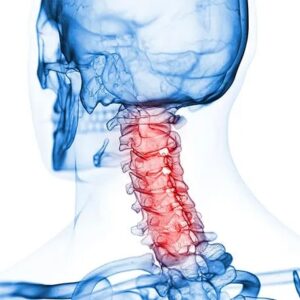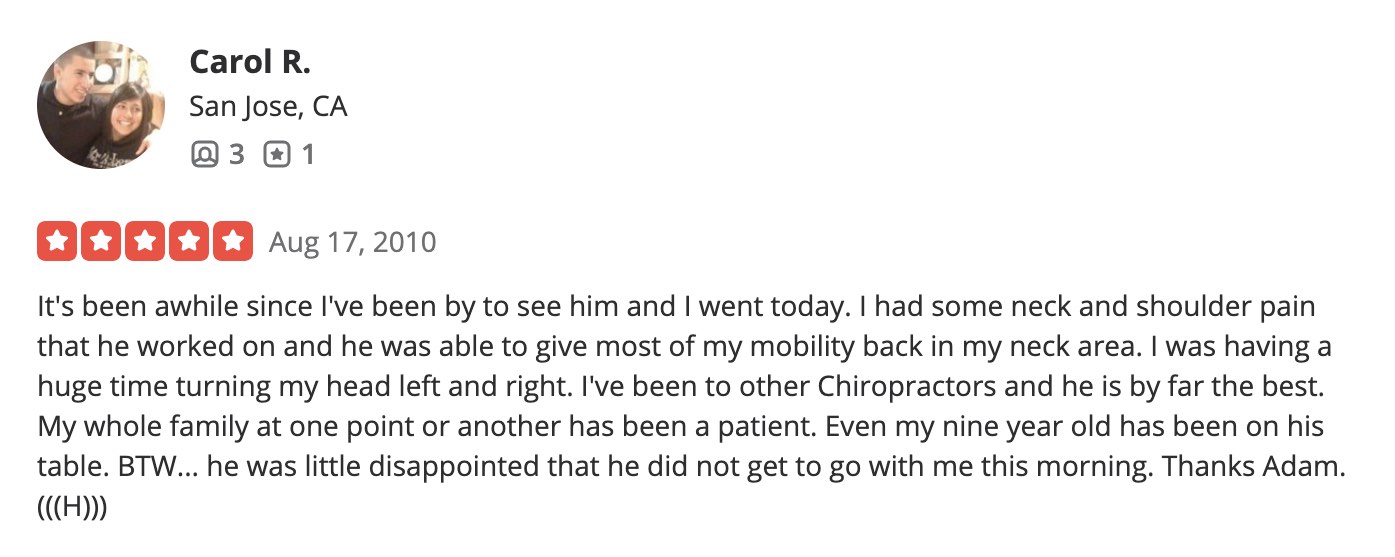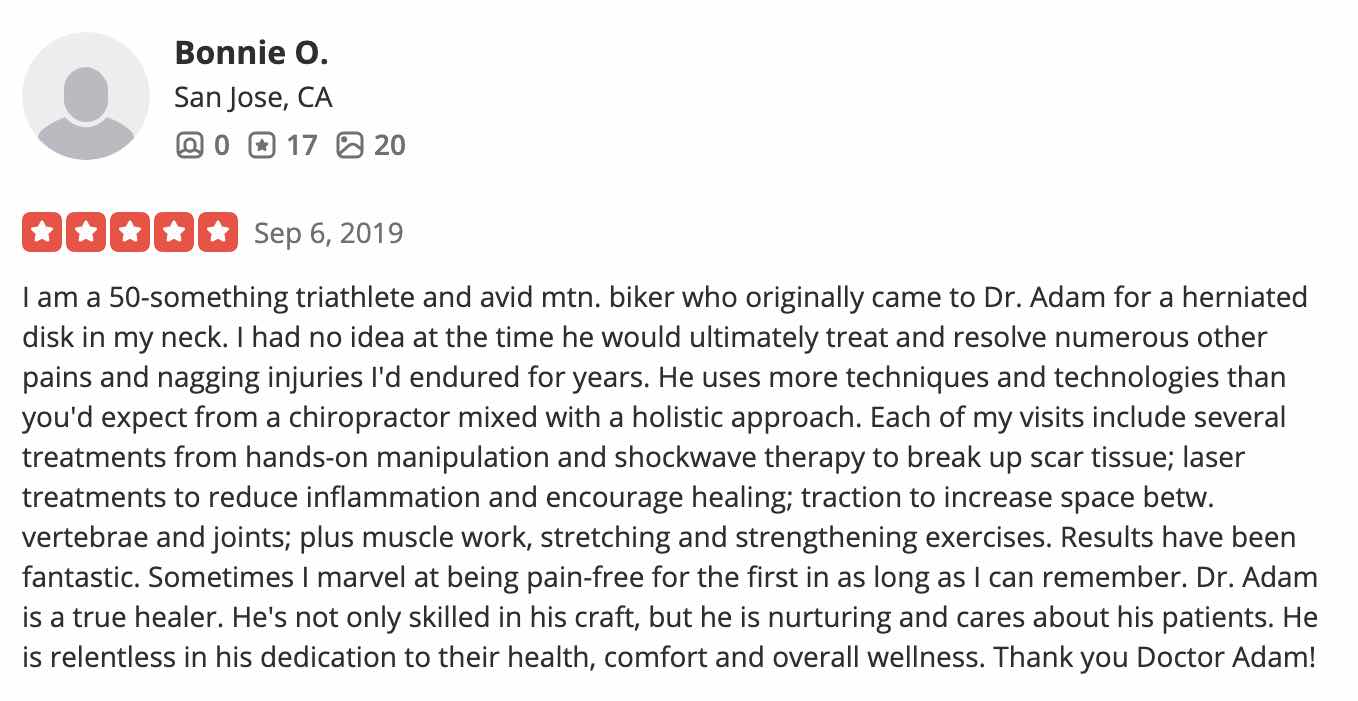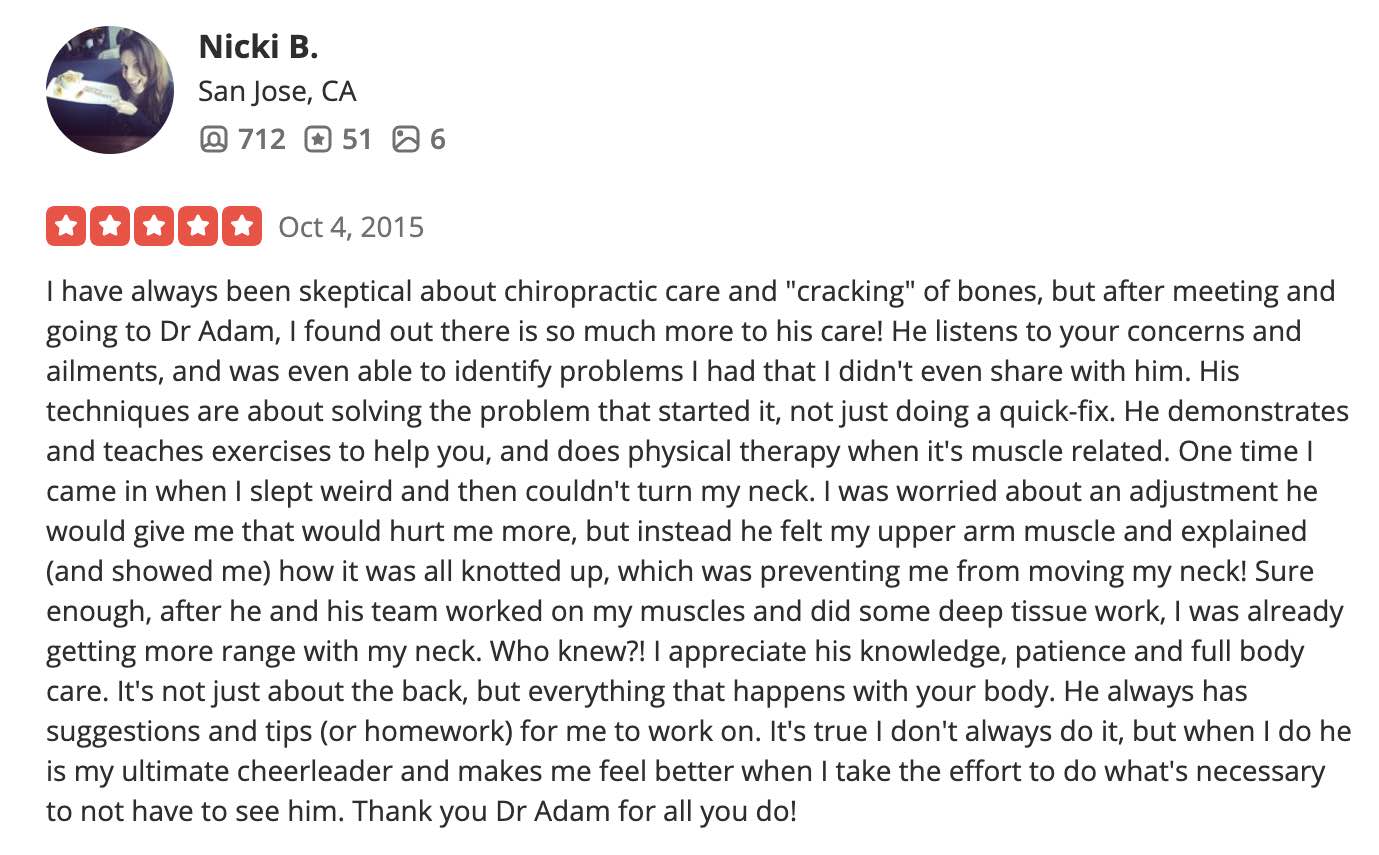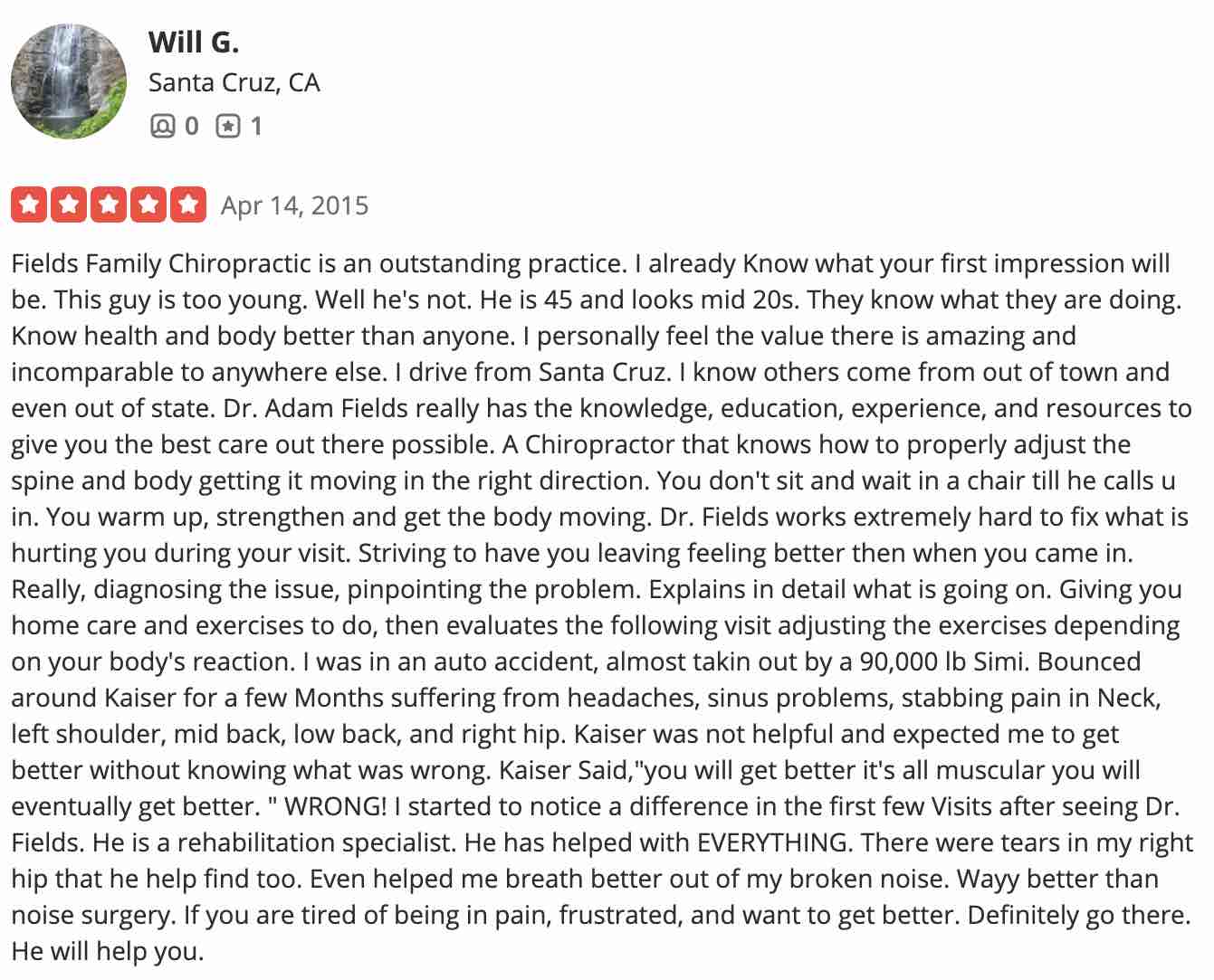Neck Pain Relief
With Top Chiropractor in Los Gatos, San Jose, SF Bay Area, CA
1/ Loss of Spinal Curves or Poor Posture and Neck Pain
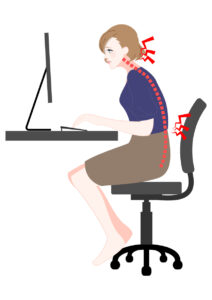
Illustration of pain of a woman using a computer in a distorted posture
When someone loses the proper lordotic curve (curve from the side) in their lumbar spine (low back), the mechanical shift is also seen in the mid back and neck. The shoulders then round forward and the neck protrudes out from the body. The neck portion is called forward head posture. Even though the weight of the head is still 8 to 12 pounds, this shift causes it to essentially weigh more as it requires more energy from the body to hold it up. Every inch the head moves forward essentially doubles the weight of the head.
Poor posture, especially during prolonged sitting or using electronic devices, can strain the ligaments of the neck and muscles of the neck and upper back. This leads to pain and stiffness as the body needs to hold the head up rather than the head being balanced over the shoulders.

Types of neck compression
A loss of curves can put undue weight onto the spinal discs leading to long-term issues like disc herniation, nerve compression, headaches and worsening neck pain. Beyond what we may feel, poor posture can decrease the speed of transmission of signals down our spinal cord, interrupt cerebrospinal fluid flow to the brain and is even implicated in early mortality.
We use the Pettibon System and the Chiropractic Biophysics (CBP) techniques for home and in-office care to correct the posture by correcting spinal curvatures.
2/ Muscular Neck Pain
Muscle strain, often caused by overuse or sudden movements, is a common cause of neck pain. Activities such as lifting heavy objects, sports, or even sleeping in an awkward position can lead to muscle strain. The muscles in the neck can become tight and sore, resulting in pain that may radiate to the shoulders or upper back.
This type of pain is typically acute and can resolve with rest and proper care in our office. The stretching and strengthening exercises on this page can help prevent muscle strain and even help you get through it.
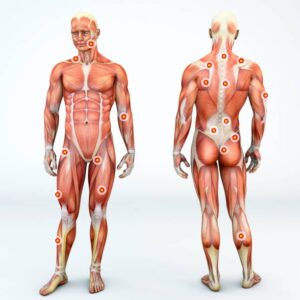
Myofascial trigger points, also known as trigger points, are described as hyperirritable spots in the fascia surrounding skeletal muscle.
Sometimes muscular trauma can lead to myofascial trigger points in the cervical spine musculature. A myofascial trigger point is a small, tight area within a muscle that is hypersensitive and can cause pain, stiffness, or discomfort in both the immediate area and referred pain to other parts of the body. For example, a trigger point could be in the upper cervical spine that radiates upward and causes a headache.
Common treatments include self massage holding on the spot for 40 to 60 seconds, stretching and, in our office, class IV laser therapy and extracorporeal shockwave therapy.
3/ Neck Cervical Disc Degeneration or Cervical Disc Herniation
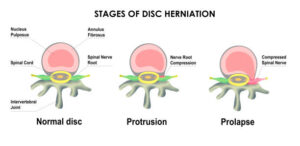
Difference between Bulging Disc and Herniated Disc. Stages of Spinal Disc extrusion.
Cervical disc degeneration occurs when the intervertebral discs in the neck wear down over time, leading to pain and stiffness. This condition is a natural part of aging, but it can be accelerated by factors such as poor posture or the loss of cervical cure or flexion injuries. As the discs lose hydration and flexibility, they become less effective at cushioning the vertebrae, leading to pain.
This degenerative process can also lead to the development of bone spurs, which may compress nearby nerves and cause radiating pain, numbness, or tingling in the arms.
As a normal cervical curve of 42° is lost the weight of the head shifts to the discs. The intervertebral discs do not have a blood supply after the age of 12. This is why grandma is shorter than she was when she was young. If the disc has less hydration it is like a bicycle tire with less air in it. The disc, like the tire, gets less stable and can start to delaminate or crack on the outside. In the tire, this would lead to the tube pushing through the sidewall. In the spine, it is the nucleus of the disc that can protrude through the fissure and become a disc herniation.
With chiropractic techniques that mobilize the spine and in-office and home repetitive traction, we can initiate disc imbibition/hydration and even a healing of the discs. This can help with pain and restore normal biomechanics.
4/ Whiplash
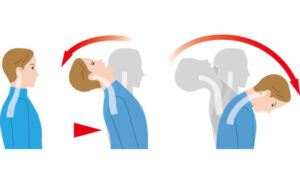
Whiplash, neck pain, rehab exercises
Whiplash is a neck injury caused by a sudden, forceful movement of the head. This often occurs in car accidents, slips and falls or sports injuries like snowboarding. This rapid motion can strain or tear the muscles, ligaments, and tendons in the neck, leading to pain, stiffness, and reduced range of motion. Whiplash can also affect the spine and nerves, causing headaches, dizziness, and even cognitive issues.
The severity of whiplash can vary, and symptoms may not appear until weeks or months after the initial injury. Early treatment is crucial to prevent long-term complications. Your body will heal according to the stresses that are put upon it. Scar tissue is laid down in a process called the “fibrosis of repair.” This full process can take 18 months. During this time it is crucial to make sure the spine is moving properly and strengthened. If left untreated, whiplash can lead to chronic neck pain and other persistent issues.
With chiropractic care, traction, home rehab protocols and modalities like extracorporeal shockwave therapy and class IV laser therapy, your biomechanics can be preserved after a whiplash injury. This will minimize the long term ill effects of whiplash injuries and upregulate the functioning of your nervous system.
In our office we help people who have been in car accidents on a regular basis.
5/ Neck Osteoarthritis
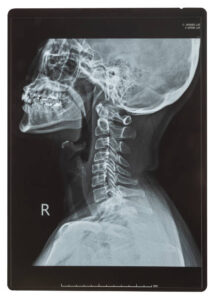
Cervical spine x-ray
Osteoarthritis in the neck is also known as cervical spondylosis. It is a condition where the cartilage in the neck joints wears down over time. This wear and tear can lead to decreased range of motion or stiffness. The condition is often associated with aging, previous injuries, a loss of cervical curve, wearing a heavy helmet for years or repetitive stress can accelerate its development.
When there is a decrease in mobility pain can result. Proper mechanics, or movement in general, sends movement signals down the same neurological pathway as pain. This can drown out pain signals. An example in everyday life would be when you accidentally hit your hand with a hammer and instinctively shake your hand afterward to decrease the pain. The same holds true with an arthritis cervical spine but the motion part can take longer. Through muscle work, traction, neck exercises, shockwave therapy, class IV laser therapy and corrective chiropractic, mobility can be restored in the cervical spine and pain decreased.
6/ Nerve Compression in Neck
The cervical spine, consisting of the first seven vertebrae. These bony structures are a strong house for your spinal cord. However, there are some parts of the spine that can pinch your spinal cord or the nerves that exit the spine. Pinched nerves, often caused by herniated discs, inflamed tissues or bone spurs, can lead to neck pain and numbness or tingling in the arms, shoulders or hands.
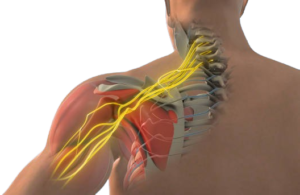
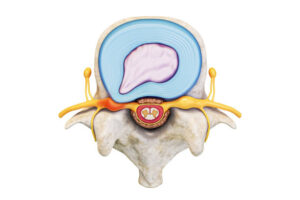
Superior view of human lumbar vertebra with herniated disk and spinal cord isolated on white background with copy space 3D rendering illustration. Anatomy, medical, backbone pathology concepts.
Treatment options in our office vary depending on the severity of the compression and the underlying cause. With a combination of directed home care and in-office care that may include spinal decompression therapy, cervical curve restoration, precise chiropractic adjustments, class IV laser therapy and more. Early intervention is preferred in preventing long-term damage and alleviating the pain. However, there can even be hope with chronic nerve compression.
Get a Chiropractic Adjustment for Neck Pain
Dr Adam Fields is a practicing chiropractor in the Bay Area in Northern California and helps people daily in his office with many challenges that can be helped by shockwave therapy from tendinopathies, arthritis, cartilage regeneration, post surgical scar tissue, pelvic pain, altered biomechanics and more. He uses Endonasal Cranial Adjusting, the Muncie Technique, Extracorporeal Shockwave Therapy (ESWT), Class IV Laser Therapy, posture correction, lifestyle modification, muscle work, and other techniques to help his patients.
You can reach Dr Adam Fields for in-person (Los Gatos and San Jose, California) or telehealth appointments here.
Neck Rehab Exercises
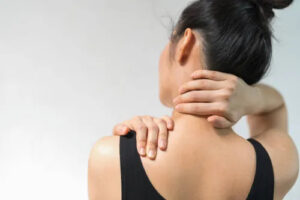
Neck pain, rehab exercises
Dr Fields is a chiropractor who will guide you through effective massage techniques for your traps, scalenes, and other neck muscles and get you some neck pain relief with the help of a massage gun.
Improve mobility and decrease inflammation
Release trigger points and tension
Perform active rotations and static stretches
This routine will leave you feeling relaxed and refreshed.
Plus: Discover additional strengthening exercises to keep your neck pain-free in the long run!
WARNING: Feeling dizzy or weird? This might mean dehydration or needing a gentler approach. We’ll provide modifications and alternative neck stretches for everyone. You may want to seek more neck pain relief, mobility and strength from Dr Fields other neck pain relief videos.
